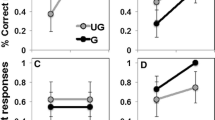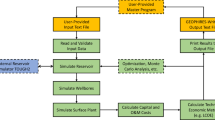Abstract
The use of simulation is a scientifically-recognized way of studying biogeochemical cycles, mainly when consecutive disturbances are made. As a pedagogical tool, simulation helps students gain insight into the response dynamics of the respective biogeochemical cycle. The development of simulation tools for educational purposes has not progressed much for the last couple of decades, despite advances in computer science. Trying to fill in that gap, this paper presents the biogeochemical cycles simulator (BCS) freeware, a more user-friendly replacement for older simulators. The BCS is a light-weight, user-friendly, Windows®-based simulator. Using the sulfur biogeochemical cycle as an example, the simulation results from two sequential disturbances were compared with those of the former tools: the sum of relative errors between the three tools was never greater than 2.7%. Moreover, a real-world event (Mount Pinatubo’s Eruption 1991) was also simulated, giving similar results to those actually measured. The major improvements made include: a friendly graphical user interface, unlimited number of reservoirs, direct input of mass fluxes, multi-disturbance assessment, and fully customizable plots. The BCS freeware has been used in case studies, in a biogeochemical cycles course of a B.S. in Chemistry at the University of São Paulo, Brazil. Simulations helped students to develop decision-making and group-working skills, as well as enhanced data interpretation. Moreover, the students were able to recognize how even small disturbances can cause short- and long-term impacts on biogeochemical cycles. A set of possible strategies for using BCS as an educational tool is also provided in this work.








Similar content being viewed by others
Data availability
The raw data can be found in the Supplementary Information.
Material availability
The raw data can be found in the Supplementary Information.
Software availability
To obtain a copy of the BCS freeware, one may access the repository listed below. Please, use the file BCS.jar to run the BCS software. http://doi.org/10.5281/zenodo.5730609.
References
Bândǎ N, Krol M, Van Noije T, Van Weele M, Williams J, Le Sager P, Niemeier U, Thomason L, Röckmann T (2014) The effect of stratospheric sulfur from Mount Pinatubo on tropospheric oxidizing capacity and methane. J Geophys Res 120:1202–1220. https://doi.org/10.1002/2014JD022137
Chameides WL, Perdue EM (1997) Biogeochemical cycles: a computer-interactive study of earth system science and global change. Oxford University Press, New York
Chamizo JA (2013) A new definition of models and modeling in chemistry’s teaching. Sci Educ 22:1613–1632. https://doi.org/10.1007/s11191-011-9407-7
Crowe S, Cresswell K, Robertson A, Huby G, Avery A, Sheikh A (2011) The case study approach. BMC Med Res Methodol 11(1):1–9. https://doi.org/10.1186/1471-2288-11-100
Eclipse Foundation (2019) Eclipse IDE for Enterprise Java Developers (4.13.0) [Software]. https://www.eclipse.org/eclipseide/. Accessed 22 Mar 2021
Farashahi M, Tajeddin M (2018) Effectiveness of teaching methods in business education: a comparison study on the learning outcomes of lectures, case studies and simulations. Int J Manage Educ 16:131–142. https://doi.org/10.1016/j.ijme.2018.01.003
García-Herreros P, Gómez JM (2013) Modeling and optimization of a crude distillation unit: a case study for undergraduate students. Comput Appl Eng Educ 21:276–286. https://doi.org/10.1002/cae.20469
García-Martínez I, Fernández-Batanero JM, Cobos Sanchiz D, Luque de La Rosa A (2019) Using mobile devices for improving learning outcomes and teachers’ professionalization. Sustainability 11:6917–6929. https://doi.org/10.3390/su11246917
Gilbert D (2014) JCommon (1.0.22) [Software]. https://www.jfree.org/jcommon/. Accessed 22 Mar 2021
Gilbert D (2021) JFreeChart (1.5.3) [Software]. https://www.jfree.org/jfreechart/. Accessed 22 Mar 2021
Gonçalves MA (2021) Boxes: software to model biogeochemical cycles. http://webpages.fc.ul.pt/~mgoncalves/software_e.htm. Accessed 22 Mar 2021
Gren L (2020) A flipped classroom approach to teaching empirical software engineering. IEEE Trans Educ 63(3):155–163. https://doi.org/10.1109/TE.2019.2960264
Hiccklin J, Moler C, Webb P (2012) JAMA: Java Matriz Package (1.0.3) [Software]. https://math.nist.gov/javanumerics/jama. Accessed 22 Mar 2021
Jacobson MC, Charlson RJ, Rodhe H, Orians GH (2000) Earth system science: from biogeochemical cycles to global change. Elsevier Academic Press, San Diego
Kwoc HCW, Langlois WE, Ellefsen RA (1971) Digital simulation of the global transport of carbon monoxide. IBM J Res Dev 15:3–9. https://doi.org/10.1147/rd.151.0003
Lant C, Pérez-Lapeña B, Xiong W, Kraft S, Kowalchuk R, Blair M (2016) Environmental systems simulations for carbon, energy, nitrogen, water, and watersheds: design principles and pilot testing. J Geosci Educ 64:115–124. https://doi.org/10.5408/14-004.1
Madsen EL (2011) Microorganisms and their roles in fundamental biogeochemical cycles. Curr Opin Biotechnol 22:456–464. https://doi.org/10.1016/j.copbio.2011.01.008
Mathworks (2021) MATLAB [Software]. https://www.mathworks.com/products/matlab.html. Accessed 22 Mar 2021
McCorrmick MP, Thomason LW, Trepte C (1995) Atmospheric effects of the Mt Pinatubo eruption. Nature 373:399–404. https://doi.org/10.1038/373399a0
McKagan SB, Perkins KK, Dubson M, Malley C, Reid S, Lemaster R, Weiman CE (2008) Developing and researching PhET simulations for teaching quantum mechanics. Am J Phys 76:406–417. https://doi.org/10.1119/1.2885199
Morgan RE, Weinberg R (1972) Computer simulation of world systems: biogeochemical cycles. Int J Environ Stud 3(1–4):105–118. https://doi.org/10.1080/00207237208709501
Oracle Foundation (2021) Java SE runtime environment (8u281) [Software]. https://www.oracle.com/java/technologies/javase-jre8-downloads.html. Accessed 22 Mar 2021
Robock A (2002) The climatic aftermath. Science 295:1242–1244. https://doi.org/10.1126/science.1069903
Veenstra P, Van Der Berg S, Frössman T, Wholers U (2019) DOSBox (0.74-3) [Software]. https://www.dosbox.com/. Accessed 22 Mar 2021
Weiman CE, Adams WK, Perkins KK (2008) PhET: simulations that enhance learning. Science 322:682–683. https://doi.org/10.1126/science.1161948
Wendel J, Kumar M (2016) Pinatubo 25 years later: eight ways the eruption broke ground. Eos. https://doi.org/10.1029/2016EO053889
Acknowledgements
The authors would like to thank The National Council for Scientific and Technological Development (CNPq) and The Coordination for the Improvement of Higher Education Personnel (CAPES—Finance Code 001).
Funding
The National Council for Scientific and Technological Development (CNPq) and The Coordination for the Improvement of Higher Education Personnel (CAPES—Finance Code 001).
Author information
Authors and Affiliations
Corresponding author
Ethics declarations
Conflict of interest
The authors declare that they have no known competing financial interests or personal relationships that could have appeared to influence the work reported in this paper.
Additional information
Publisher's Note
Springer Nature remains neutral with regard to jurisdictional claims in published maps and institutional affiliations.
Responsible Editor: Fiona Soper.
Supplementary Information
Below is the link to the electronic supplementary material.
Rights and permissions
About this article
Cite this article
Magioli Cadan, F., Xavier, C. & Bessa Azevedo, E. Modeling and simulating biogeochemical cycles: the BCS freeware. Biogeochemistry 158, 373–382 (2022). https://doi.org/10.1007/s10533-022-00904-0
Received:
Accepted:
Published:
Issue Date:
DOI: https://doi.org/10.1007/s10533-022-00904-0




